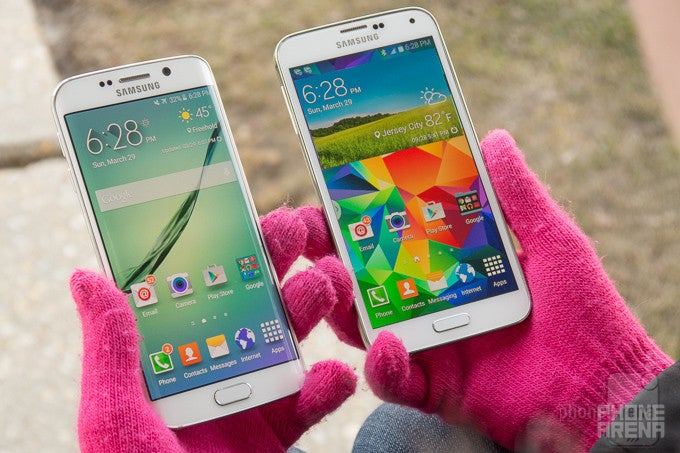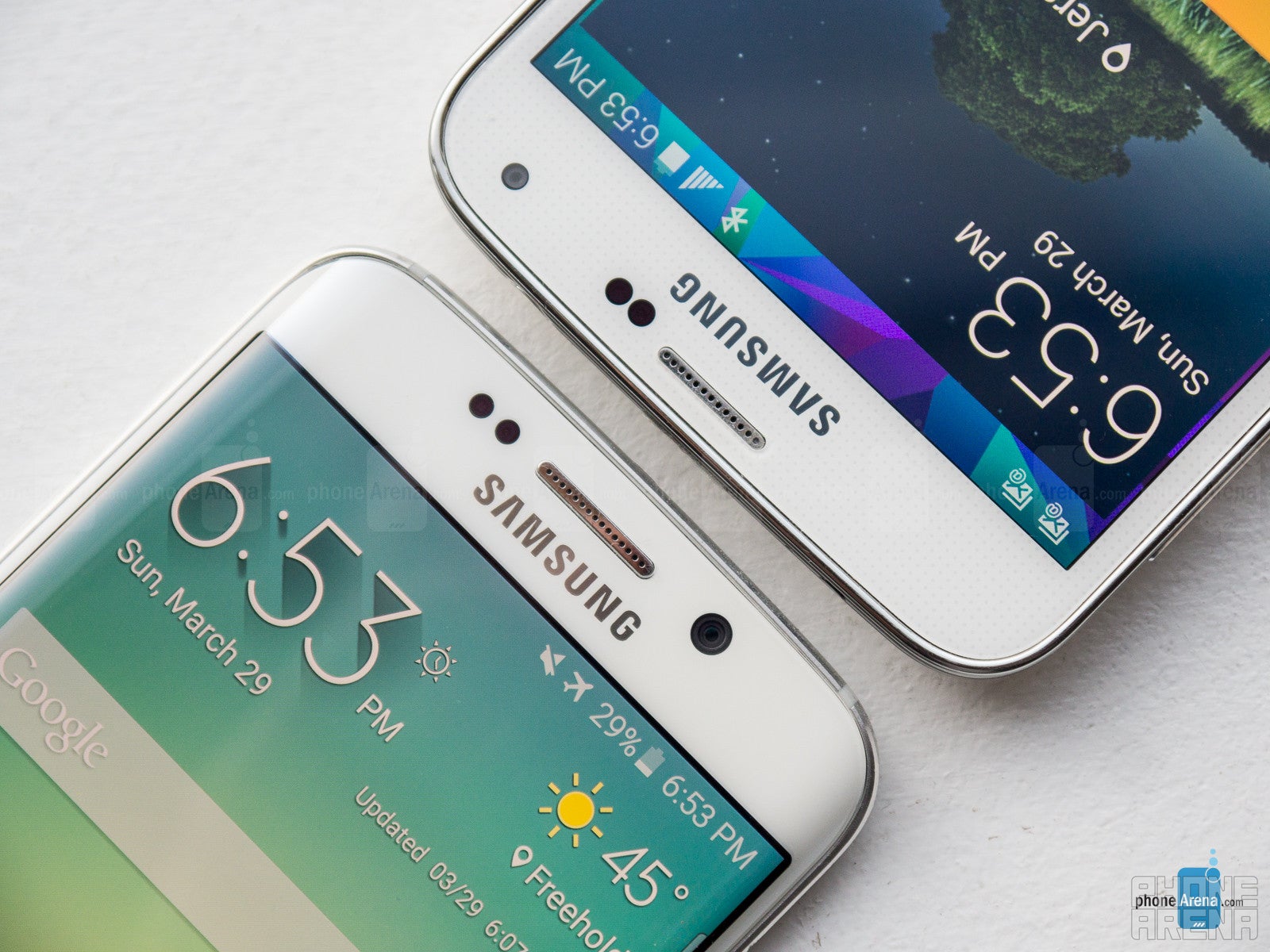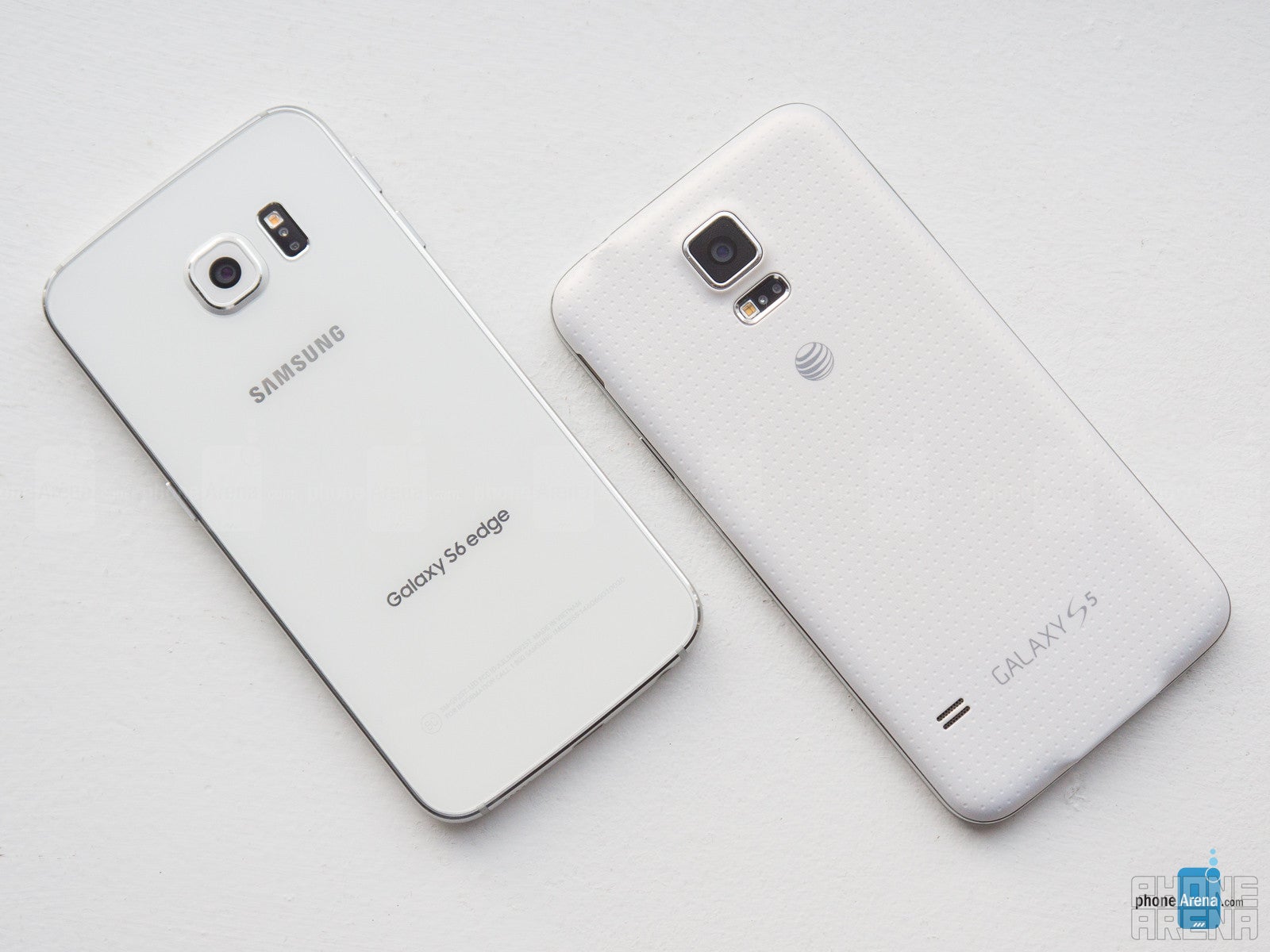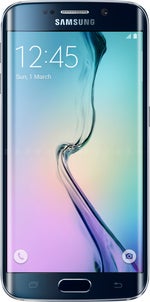Samsung Galaxy S6 edge vs Samsung Galaxy S5

Introduction
Samsung simultaneously outed two flagships this year – the regular Galaxy S6, and a uniquely designed handset that has its screen sloping on both sides – the Galaxy S6 edge. As customers will be mostly divided between the regular S6 and the S6 edge this year, we find another important decision some consumers will likely face: the Galaxy S6 edge or last year's Galaxy S5, which is still a superb phone, now at a more alluring price point.
There are many things that make the new Galaxy S6 edge highly desirable by tech heads, such as its impressive Quad HD display, or the new, much more premium design language. Still, the Galaxy S5 can in no way be called a slouch, as it too has a trick or two up its sleeve.
Can the unique screen and stellar specs of the S6 edge compensate for ditching the waterproof rating and replaceable battery that the now cheaper Galaxy S5 has? Read on to find out...
Design
Galaxy S6 edge is a uniquely designed handset that will probably stay cool long after the S5 has sunk into oblivion.
The Galaxy S6 edge has one stark design difference with the S5, or with any other handset this side of the Note Edge, for that matter, and it is its “dual edge” display, wrapped around both sides of the phone. While you can argue about the practical applications of such a curved solutions, the cool factor is undoubtedly there.
Furthermore, the S6 edge flaunts an elegant metal chassis with reinforced reflective glass surface, nanocoated in several colors, including an exclusive emerald green. The Galaxy S5, on the other hand, might sport a lowly dimpled soft touch plastic back, but the cover lifts off, letting you swap the battery, even though the phone has an IP67 waterproof rating, allowing you to submerge it in up to three feet of water for half an hour.
The S6 edge is easier to hold and operate with one hand, as it is narrower, thinner and lighter than the S5. When it comes to physical keys, they are conveniently placed around both phones, and with good tactile feedback.
Speaking of buttons, the home key underneath the display of the Galaxy S6 edge still incorporates a fingerprint reader, just like on the S5, but this time it is of the more convenient touch sensor variety that recognizes your prints with a simple tap only, instead of swiping over the whole thing. Samsung also intros a double-tap gesture for launching the camera with the S6's home key directly, without even unlocking the handset, which is a great feat to have.
Looking at the back, we find both handsets donning a 16 MP camera placed right in the upper middle, which is a fine placement, so that your fingers won't try to get into the frame while shooting in landscape mode, for instance, as it so often happens with cornered cameras. In a nutshell, the Galaxy S6 edge is uniquely positioned to become one of the coolest handsets design-wise out there, which can't really be said for the S5.
Displays
The side-sloping S6 edge panel doesn't add some exorbitant value, but looks cool, and sports way more credible colors than the S5.
The phones have the same screen diagonals – 5.1” - but different screen resolutions. The Galaxy S5 dons a 1080 x 1920 resolution, while the S6 edge has the most pixel-dense display on a mobile, with a 1440 x 2560 pixels screen that has a record 577ppi count, so you'd never notice individual pixels with a naked eye, no matter how close you look. The flexible AMOLED display is made with a plastic, instead of a glass substrate, allowing Samsung to bend the screen left and right, wrapping it around both sides, and placing a thermoformed reinforced glass on top for added protection. The Galaxy S5 has a more orthodox flat panel with Gorilla Glass 3 cover.
We've grown accustomed to expecting very cold, oversaturated and incorrect colors from Samsung's AMOLED screens, at least until the Note 4, and the Galaxy S5 is no exception. The S6 edge, on the other hand, carries over the nice trend from Samsung's latest phablet, and exhibits accurate colors in its Basic mode, plus a white point that is very close to the reference 6500K mark, unlike the outlandish, cold tint of the Galaxy S5 display.
Outdoor visibility is excellent on both handsets, given that, in auto light sensor mode, both phones get boosted to a very high peak brightness under direct sunlight, and they have low screen reflectivity ratio, too. The phones offer a super-sensitive touch layer that can be turned on and off at will, allowing you to operate the screen with gloves on, for instance.
Interface
Samsung equipped the Galaxy S6 edge with a TouchWiz that is more streamlined than on the S5, plus an enormous cloud storage amount in partnership with Microsoft.
Both handsets sport Samsung's TouchWiz over Android 5.0 Lollipop, but the company has streamlined it further on the Galaxy S6 edge, cleaning out the perplexing variety of options a bit, and introducing a tad less bloat. Another new thing is the inclusion of Microsoft apps out of the box. Microsoft's OneDrive cloud service, for instance, comes preinstalled on the S6 edge, and with it arrive 115 GB of free storage for two years, pretty generous, but you also get Skype and OneNote out of the box, too.
The S6 edge has a dedicated settings category for managing the functionality of the curved display. The sides can glow in a few different colors assigned to individual callers when the phone rings, for instance, or you can adjust the content they show when the phone is locked, like weather, stocks, news, notifications, and so on. Having the interface, apps and media stretched over a curved display seems a bit strange at first, but you eventually get used to it.
As usual, Samsung throws most every functionality imaginable in its TouchWiz interface, such as the Multi-Window regime, the Pop-up View mode, and so on. We also get a useful one-handed mode on both handsets, that can shrink the whole interface left or right, as if you are using a handset with a much smaller screen.
Besides the streamlined TouchWiz and the 115 GB One Drive integration, Galaxy S6 edge has another feature advantage before the S5, and it is called Samsung Pay. This software/hardware combo lets you store all your credit and debit cards in the phone, and authorize payments with the touch fingerprint scanner anywhere magnetic stripe cards are accepted, which is millions of locations worldwide. Samsung Pay will be live in the US in the summer, with a global rollout to follow.
Processor and memory
The new flagship is truly living at the edge of chipset and memory technology, so even the clumsy TouchWiz seems fluid compared to the same interface on the S5.
The Galaxy S6 edge is powered by the company's newest octa-core 64-bit Exynos 7420 SoC with Mali T-760 GPU, built with the latest 14nm production process, making it both fast and frugal. It has four Cortex-A57 cores, clocked at 2.1 GHz maximums, and four 1.5 GHz Cortex-A53 cores. These are arranged in a big.LITTLE architecture that kicks in the powerful and power-sapping A57s only when needed.
That processor is already among the fastest mobile chips out there, this side of Nvidia's K1, but it also got paired with 3 GB of the most advanced DDR4 RAM, and 32 GB/64 GB/128 GB of Samsung's newest UFS 2.0 storage type, making the S6 edge truly the best you can currently get in the Android world in terms of speed and horsepower. TouchWiz, which is usually a bit crummy and laggy, has nothing on this combo, and runs like a charm; the same goes for any third-party app you would throw at the S6 edge.
Galaxy S5 runs on a year-old chipset - Snapdragon 801 clocked at 2.5 GHz - which still runs the interface and apps without much issues. Last year's flagship has 2 GB of DDR3 RAM, plus 16 GB of storage for the basic version, and a microSD slot for more. There are some delays in transitioning and redrawing while flicking the interface around, but nothing too bad. Still, the new Galaxy S6 edge's chipset wipes the floor with the S5's silicon, and it shows in the benchmarks below.
Internet and connectivity
Next to the S5, Galaxy S6 edge comes with all the latest and greatest in connectivity, both on the wired, and on the wireless side.
Samsung has equipped the Galaxy S5 and S6 edge with two browsers – its own TouchWiz piece, and Google's Chrome. The browsers on both handsets perform very well while scrolling, panning around, or zooming, but we would give our preference to the TouchWiz renderer – it's not with the prettiest of interfaces, but is faster, and lets you sideload Adobe Flash. Moreover, with the screeching chipset on the S6 edge, this browser just flies in rendering, and offers one of the smoothest browsing experiences we've seen.
The phones flaunt 4G LTE connectivity, with market-dependent bands support, and 42 Mbps HSPA+ radios. Snapdragon used to be LTE king, but the Exynos chipset is now paired with Intel's latest XMM7260 modem, like in the Note 4, which supports up to 30 LTE bands (22 on a single SKU), making the S6 edge a phone ripe for globetrotters. It also offers 300 Mbps LTE Cat. 6 download speeds, while Snapdragon 801 maxes out at 150 Mbps Cat. 4, not that many carriers will supply those speeds anyway.
We get Wi-Fi/ac, Wi-Fi Direct, Bluetooth (4.0 for the S5, 4.1 for the S6), A-GPS, DLNA, and NFC on the phones, so all the basics are here. An infrared sensor for controlling your home electronics is added to the mix with the Galaxy S5 and S6 edge. Both handsets offer MHL ports for wired connectivity, letting you hook them directly, or through an adapter, to a TV. The Galaxy S6 edge, however, is equipped with the next-gen MHL 3.0 standard, which can output 4K video, if you happen to have such a television set handy, and will also charge the phone in the process. On the other hand, the S5 comes with a USB 3.0 standard, while the S6 edge relapses to USB 2.0.
Cameras
Despite identical resolutions, Galaxy S5 gives way to the S6 edge's camera quality by a large margin.
Both the S6 edge and S5 have a 16 MP camera module on the back with a single LED flash, but the S6 camera is equipped with an optical image stabilization mechanism. The sensors are 1/2.6” in size, and here is where the similarities end. Instead of the bog standard f2.2 aperture of the S5, the Galaxy S6 edge offers a whopping f1.9 aperture and 28mm focal length equivalent, which throws a wider frame net than the 31mm equivalent of the S5.
As for the frontal cameras, while the S5 comes with your run-of-the-mill 2 MP shooter, Samsung placed a 5 MP wide-angle unit on the S6 edge, capable of 1080p video recording, and real-time HDR both for stills and video. Samsung's Phase Detection technology on the S5 lets it focus very quickly even in low-light scenarios, and the S6 edge is no worse, adding Tracking AF to the mix, which lets you follow and snap fast-moving objects without blur. While shot-to-shot times are a fine second or two on the S5, depending on the quantity of light around, the Galaxy S6 edge performs even faster, due also to the quick memory lane it has that records the shot almost instantaneously.
The Galaxy S5 camera interface sports a bewildering variety of shooting modes, color effects, and neat depth-of-field tricks. These are present on the S6 edge, too, though it has a slightly less cluttered interface, and more options to choose from, such as real-time HDR, Fast Motion, VR 360, and others. Galaxy S5 has manual shooting options, letting you change the ISO and exposure, for instance. The S6 edge offers a so-called Pro shooting mode, which, however, offers the same adjustments, and still no shutter speed management, so it is on par with the S5 in the manual settings aspect.
Both phones produce detailed, high-quality photos in good lighting. There are differences in color representation, though – the snaps taken with the Galaxy S5 have a mostly realistic outlook, while the Galaxy S6 edge doesn't stay away from that same quality. The new flagship boosts the color saturation a tiny bit, when compared to the real scene, too. One of the strong points of Samsung flagships, detail is plenty with both handsets, but the Galaxy S6 edge really takes you to school in that regard, which is especially visible in close-ups. The S6 edge also sports a tad better dynamic range, catching both shadows and bright objects without leaning towards one or the other.
At night, however, the game develops completely on the Galaxy S6 edge's side. Thanks to the wider aperture and OIS tech, it captures much brighter scenes, with more detail and less blur. Sometimes the shots from the Galaxy S6 edge have more noise than is advisable, without being sharper, but the S5 is so much worse in low-light photography, that this is a small bone to pick.
Both handsets can record 4K video at 30fps, as well as 1080p footage, plus HD slow-motion. The videos from the S6 edge are amazing, with a great amount of resolved detail, fine color presentation, and almost instant continuous autofocus. They sometimes get a tad choppy when panning quickly around, but you can always turn on the 60fps mode, and the imagery will just float around without a hiccup, though looking a bit unnatural. Galaxy S5 also shoots very smooth and pleasant videos with a good amount of detail, though the colors appear a bit colder than reality, and continuous autofocus is not as fast as on the S6 edge.
Multimedia
It's rather weird to watch videos on a curved display, but the Galaxy S6 edge throws in the 1440p VP9 efficient streaming codec, while both phones support every major video and audio format.
Both galleries offer grid thumbnail views, and allow for rich picture editing from within the apps, as well as sport plenty of sharing options. Video playback is excellent on both handset, too, as they support DivX/Xvid/MKV files out of the box, and the players offer plenty of extras.
The S6 edge, however, sports the world’s first 1440P/VP9 hardware based codec for energy-efficient streaming video. Here comes the only complaint we have about that bendy-curvy S6 edge display – watching videos on a wraparound screen is quite the unorthodox experience, and we'd gladly take a flat panel here, instead of the curved one.
When it comes to the music players, Samsung's TouchWiz has plenty of equalizer and visualization options built in, but the graphical environment still leaves something to be desired. Galaxy S5 and S6 edge offer one loudspeaker, which is strong enough, but with a subpar quality on the S5.
Call quality
Decent, but not stellar – this about sums up call quality on both the Galaxy S6 and Galaxy S5.

Battery
Galaxy S6 edge manages to outlast the S5 in out battery test, despite the smaller battery and the nutty specs.

Surprisingly enough given the smaller battery and better specs, the Galaxy S6 edge achieved more than that - 8 hours and 11 minutes – bringing it into our “excellent” category. It should be noted that the screen brightness couldn't be brought up to our standard 200 nits mark that we use for testing, but stayed about 180 nits, which might explain a part of this superior battery life for the S6 edge. The phone also offers built-in multistandard wireless charging, and rapid juicing for 10 minutes will provide you 4 hours of usage, according to Samsung.
Conclusion
The Galaxy S6 edge launches a multipronged assault on any handset that dares to challenge it, and last year's S5 inevitably falls a victim to its uniqueness. It's not only the futuristic dual edge screen that the S6 edge wields, but also the premium glittering chassis that runs circles around the Galaxy S5's soft plastic, scoffing at the fact that the S6 edge doesn't have a waterproof rating like its predecessor.
With its not-that-useful, yet rather extraordinary looking curved display, record-breaking silicon, a better camera, longer battery life, and Samsung Pay service, the S6 edge is very easy to pick compared to the Galaxy S5. Until you arrive at the pricing, that is.
The S6 edge is more than twice as expensive as the S5, so you should really consider if you need the curved display premium. If you are into new and cool, though, the S6 edge is as futureproof as they get at the moment, and will probably hold its value for a long time, unlike the S5's assets that started depreciating rapidly the moment it launched.

Samsung Galaxy S6 edge
Pros
- Premium design
- Highest pixel density on a phone
- Color-accurate display in Basic mode
- Top-shelf processing power
- Great camera with OIS
Samsung Galaxy S5
Pros
- Much cheaper
- Removable battery
- Expandable storage
- Longer battery life
Follow us on Google News
























Things that are NOT allowed:
To help keep our community safe and free from spam, we apply temporary limits to newly created accounts: